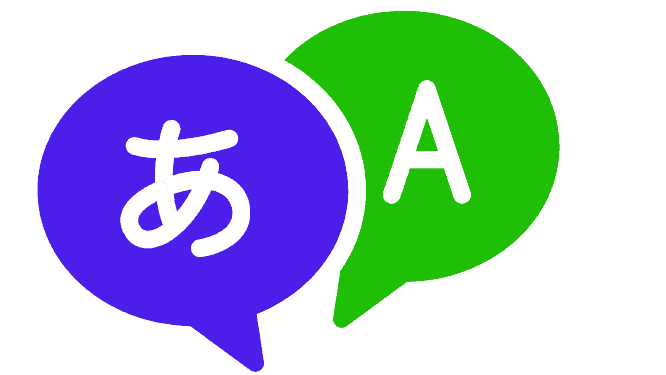Learning a new language can be fun and advantageous. But, it can also be stressful, especially if you don’t know where to start. If you’ve never used Rosetta Stone before, you might feel confused about how to use the application in order to start pursuing your language-learning objectives. Don’t worry – you’re not alone! Rosetta Stone offers several language learning features.
We’ll give you a step-by-step tutorial on how to use Rosetta Stone in this blog post. We will give advice on how to get the most out of your learning experience. You will feel more confident and ready to enter the world of language learning with Rosetta Stone. Let’s get going!
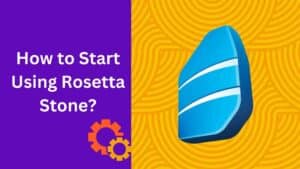
Rosetta Stone app Features
- Mobile Language Learning: With the Rosetta Stone app, you can learn a new language on-the-go. You can access all of the program’s features from your smartphone or tablet. Thanks to the app, which is compatible with both iOS and Android devices.
- Speech Recognition Technology: To help you with pronunciation and speaking, the Rosetta Stone app makes use of voice recognition technology. You’re able to swiftly alter and enhance your speaking abilities thanks to the app’s real-time feedback on your pronunciation.
- Adaptive Learning: Based on your progress and preferred learning methods, the Rosetta Stone app will tailor your learning experience. As you go through the program, it adapts to your performance and offers encouragement and feedback.
- Offline Access: The Rosetta Stone app allows you to download lessons. You can access them without an internet connection, making it simple to continue studying even when you don’t have one.
- Gamified learning: The app has games that make learning a pleasant and interesting experience. Your language abilities will be reinforced via interaction and participation in the games.
- Audio Companion: Using the audio companion function of the program, you can talk to native speakers and improve your listening comprehension abilities. The audio companion can be downloaded and used offline, making it easy to practice your language skills on-the-go.
How to use the Rosetta Stone app?
Interface overview
Once you’ve chosen a language to learn, it’s time to familiarize yourself with the interface of Rosetta Stone. You can concentrate on learning the language rather than navigating the application. The interface is intended to be user-friendly and intuitive.
The main screen of Rosetta Stone shows your course and progress as well as buttons to begin a new lesson, go back and review previous lessons. You’ll see the current activity and visual and auditory clues to help you grasp new words and phrases when you start a session.
You’ll have the chance to communicate with the programme using the writing tool and voice recognition technologies during each course. While using the writing tool, you can work on your spelling and handwriting. The voice recognition technology lets you practise your pronunciation and get accurate feedback.
As you progress through the programme, you will also have access to features for monitoring your learning and identifying areas in which you need to grow. These features include a progress report that shows your level of general competency. It will highlight the areas in which you must improve, as well as feedback on specific exercises that could help you perform better.
Select a Language
Selecting a language for learning is the first step after setting up an account and downloading Rosetta Stone on your device. More than 24 languages, including Spanish, French, Mandarin, Arabic, and others, are available as courses with Rosetta Stone.
Here’s how you choose a lesson in the app:
- Open the app on your mobile.
- Click on the gear icon (top-right).
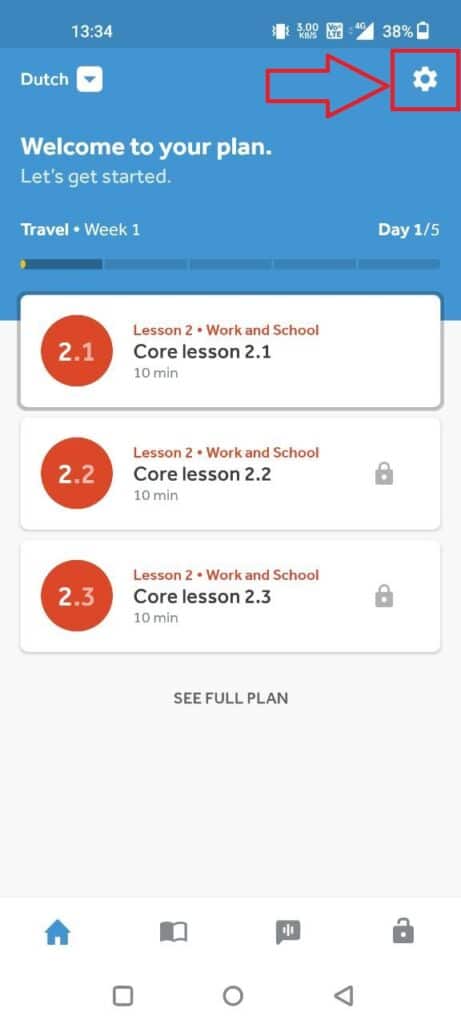
- Under My languages, click on “Learning Language”.
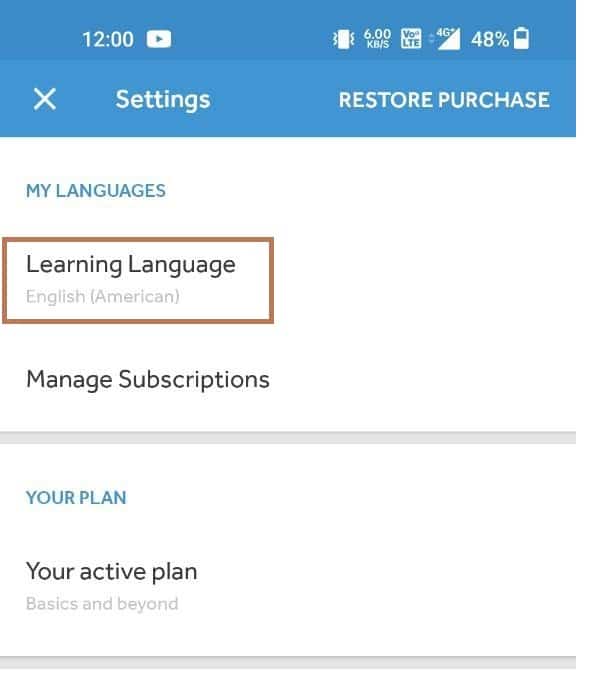
- Choose a language of your interest. (24 languages are available).
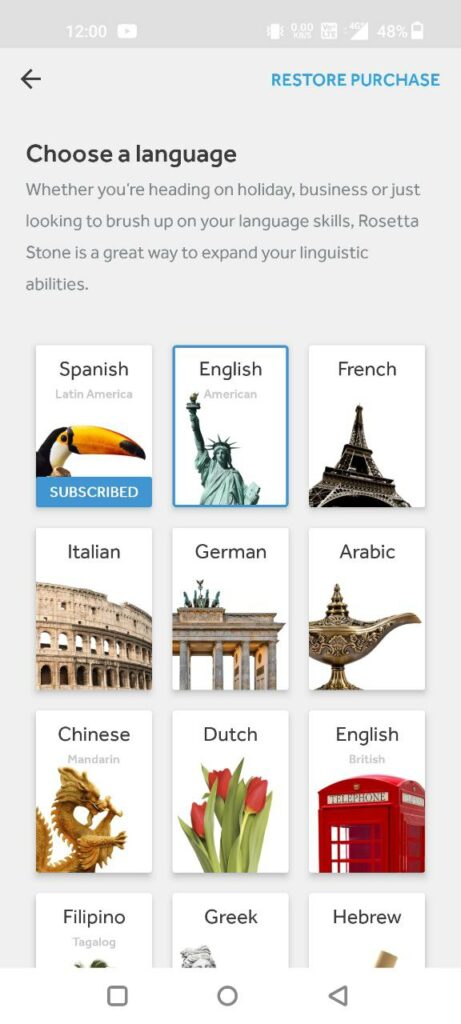
- App will take some time to load the new language course. Press the back button & you should see this screen:
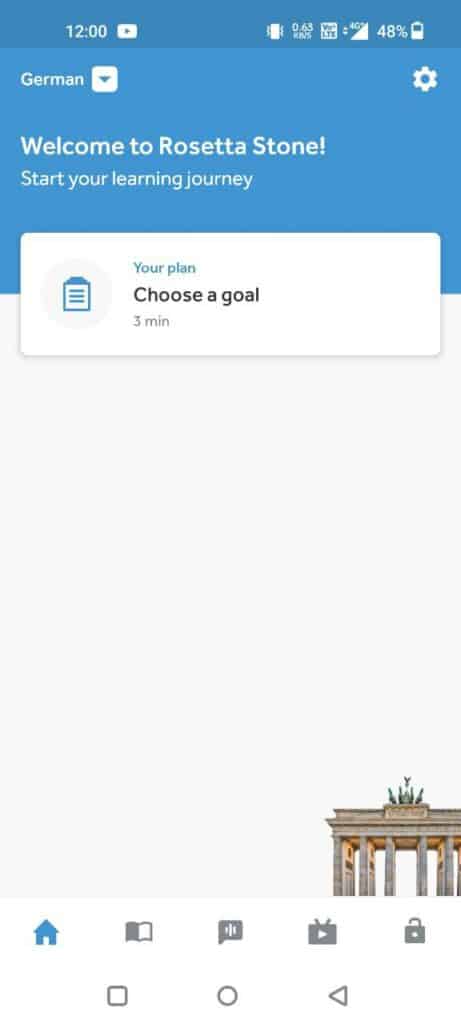
When selecting a language, you should also consider your current proficiency level. Rosetta Stone provides courses for beginners, intermediate learners, and advanced learners. Therefore, it is essential to select the appropriate course for your level. Take the placement exam to find out your skill level and get suggestions for the best course if you’re not sure which one to take.
Once you’ve decided on a language, you can start looking into the features and learning resources. It offers a thorough language learning experience that is customised to your unique requirements and learning style. it includes interactive courses, voice recognition technology, a writing tool, and progress monitoring tools.
Basic Settings
Before you start learning, there are some basic app settings that is must for the best experience. Here’s how to configure the Rosetta Stone app:
Select Your Plan
- Open the app home screen & click on the gear icon at top-right.

- Under Your Plan, click on Select your level.
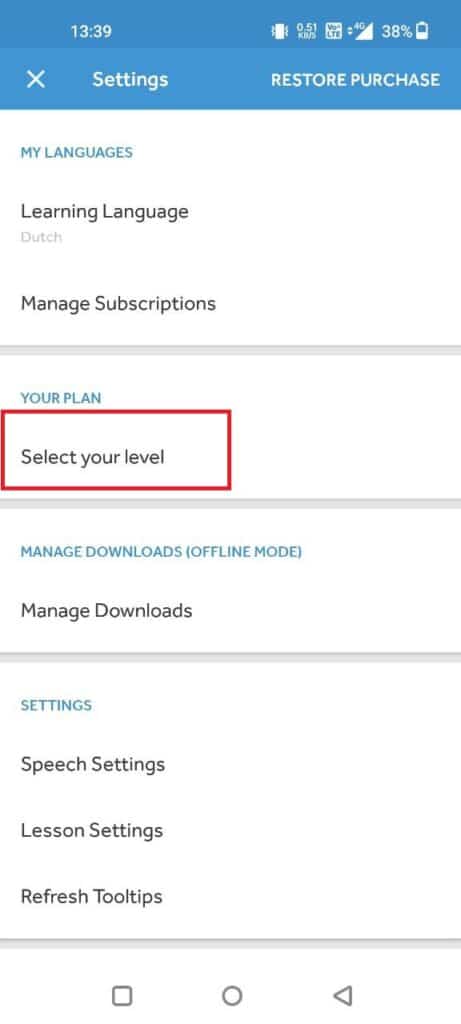
- On the next screen, Click either on Beginner, Intermediate & Proficient, based on your command in the selected language.
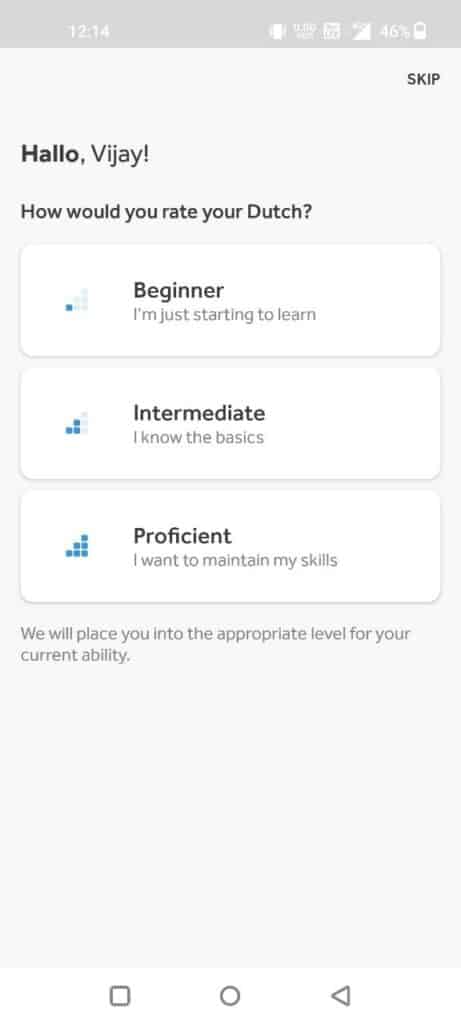
- Next, select why you want to learn this language.

- Wait for sometime & done.
Speech Settings
- Under Settings, go to Speech Settings.
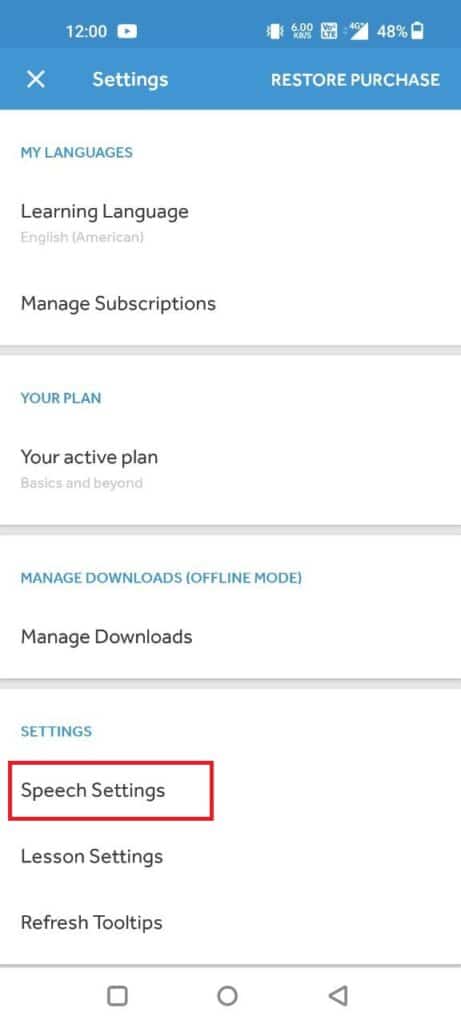
- Keep the setting as below, and select if you are a male, female or a child.
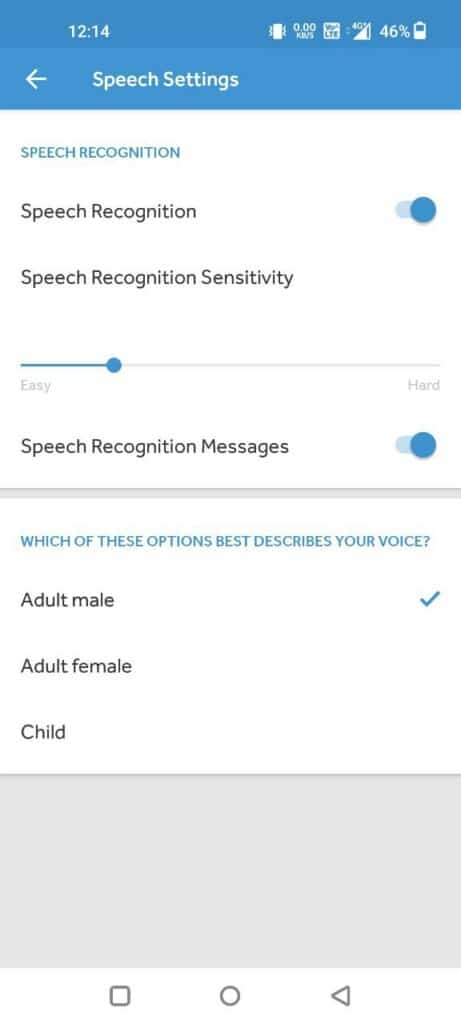
- Wait for the settings to take effect.
Lesson Settings
- Go to Settings->Lesson Settings.
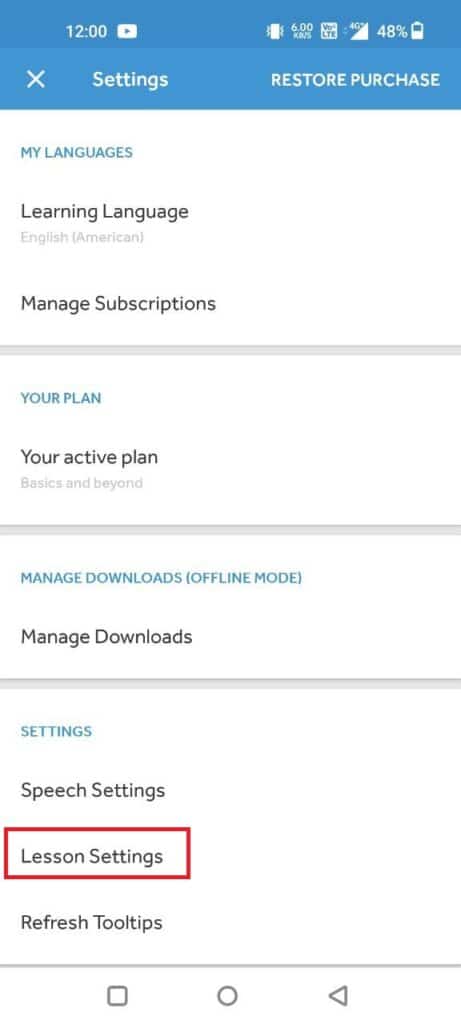
- Select your learning focus & set the additional settings as follows:
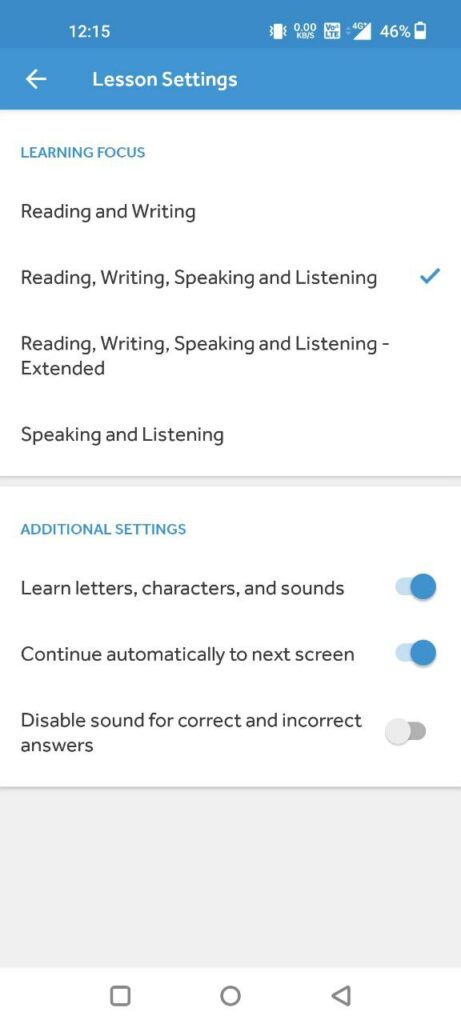
Starting a lesson
After you select a language to learn, the next step is to start the first lesson. Here’s how to do it:
- Launch the Rosetta Stone app.
- Click on the Language Basics (Unit 1) in the yellow card.
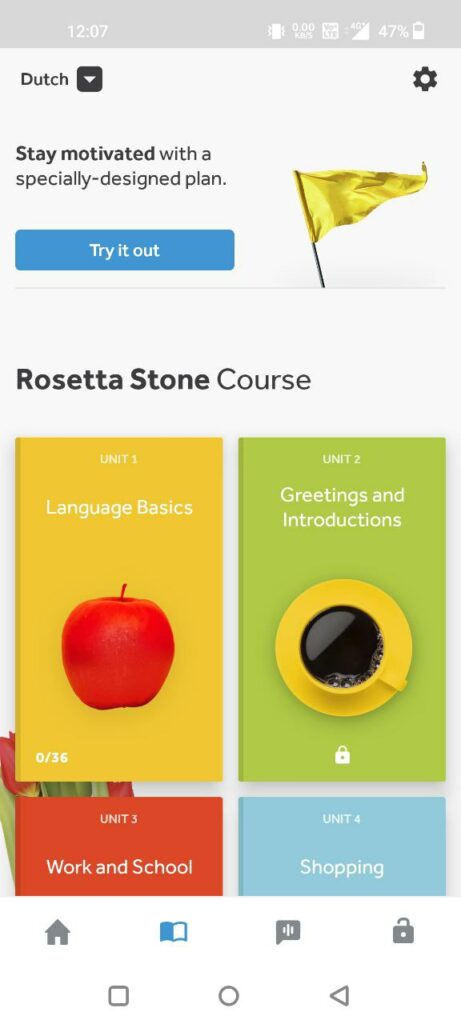
- You will see Lesson 1 with core lessons 1.1, 1.2, 1.2 and so on.
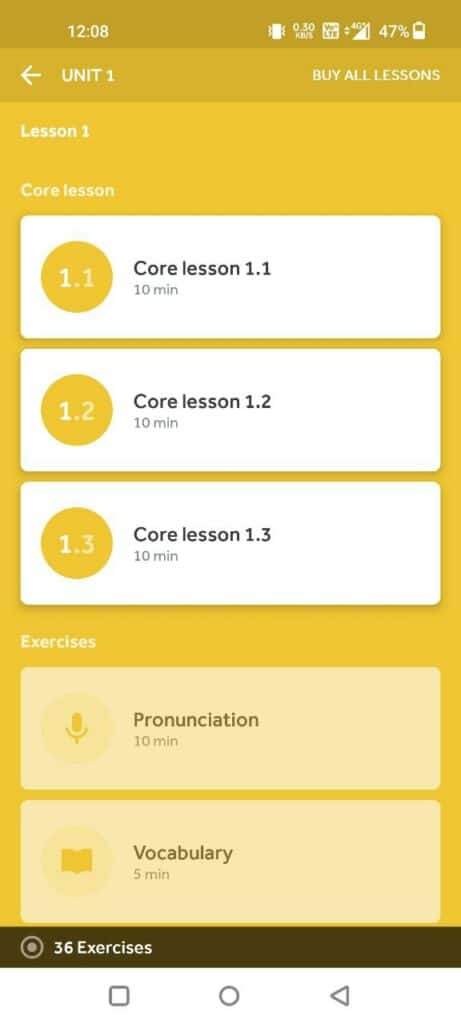
- Click on the Core lesson 1.1.
- On the next screen, click on the green button “Start Learning”.
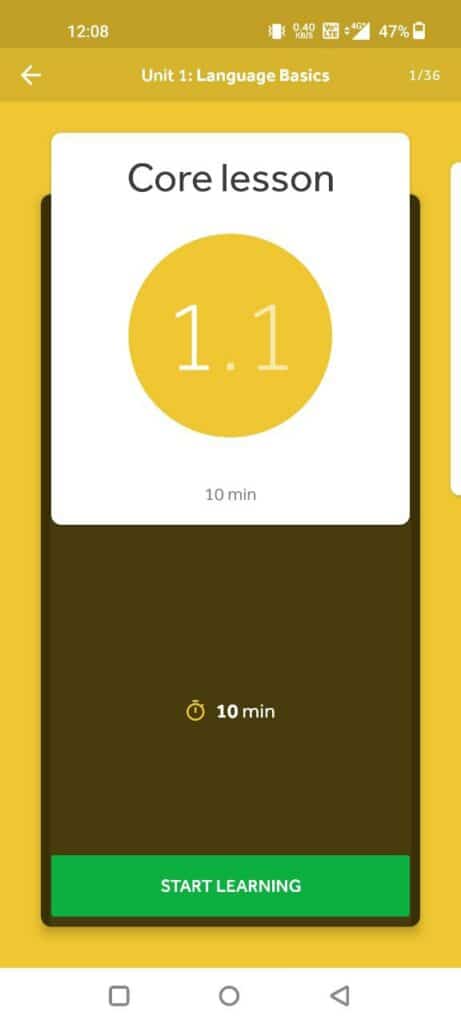
- You have to listen the word carefully & pronounce it.
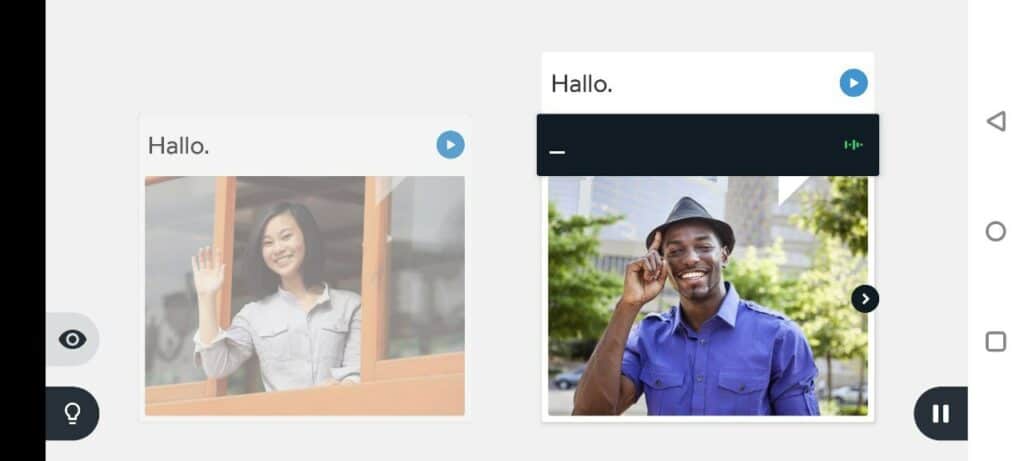
- Keep going & unlock next lessons.
Open the course dashboard and choose the desired activity to start a lesson in Rosetta Stone. It’s vital to start with the first lesson and go through the lessons sequentially since each one is intended to build on the abilities you’ve learnt in prior chapters.
When you choose an lesson, the lesson screen will appear. A series of interactive games and activities will expose you to new words and phrases. You’ll get the chance to hone your speaking, listening, and writing abilities while hearing and seeing the language in context. If you want to start over, reset the language progress to the beginning.
Making most of Lessons
There are many engaging tools and cues on the lesson screen to help you learn the language well. These consist of:
Audio cues: You can learn accurate pronunciation and intonation by listening to native speakers speaking the language you are learning.
Visual cues: To grasp new words and phrases in context, you’ll see pictures and videos that explain their meanings.
Speech recognition: Rosetta Stone’s voice recognition technology gives you the chance to practise your speaking abilities and get feedback on your pronounciation.
Writing tool: Rosetta Stone’s writing tool gives you the chance to hone your writing and spelling abilities.
You can monitor your progress and get performance comments at any time throughout the class. This will enable you to pinpoint your areas for growth and focus your efforts towards enhancing your skills in the language.
After finishing a lesson, you’ll have the chance to assess your progress before moving on to the next assignment. By continuing through the programme in this manner, you’ll be able to steadily develop your abilities and eventually meet your language learning objectives.
Understanding the learning process
Each level of Rosetta Stone’s learning process is designed to help in the progressive and efficient improvement of your language proficiency. These phases comprise of:
Vocabulary development: In the beginning of the programme, you’ll concentrate on expanding your vocabulary by being exposed to new words and expressions. This is accomplished via a number of interactive exercises and activities created to assist you in learning new terms in context.
Building fluency: As you go through the curriculum, you’ll start to concentrate on improving your language proficiency. This is done via a variety of exercises that let you utilise the language in everyday situations and increase your confidence in speaking, writing, and comprehending it.
Utilizing speech recognition technology
Rosetta Stone’s voice recognition technology lets you improve your pronunciation and get feedback. Using a variety of interactive activities and exercises, this technology is intended to help you enhance your speaking abilities in a natural and intuitive manner.
A microphone connected to your computer or mobile device is needed to utilize Rosetta Stone’s voice recognition technology. You’ll notice a prompt on the screen requesting you to say a word or phrase in the target language as soon as you’re prepared to start a speaking exercise.
The software will check your pronunciation as you talk and give you comments on how well you did. This might use both auditory feedback to assist you improve your intonation and accent as well as visual signals to point out where you’re making mistakes.
You can hone your speaking at your own speed, thanks to Rosetta Stone’s versatile and adjustable voice recognition technology. You may repeat a word or phrase as many times as necessary until you are comfortable with how it sounds. We can also change the speaking activities’ difficulty level to suit your level of proficiency.
We can use Rosetta Stone’s voice recognition technology to enhance your speaking abilities in a natural and intuitive manner, gradually boosting your confidence and fluency in the target language.
Using the writing tool
In addition to its speech recognition technology, Rosetta Stone additionally comes with a writing tool that allows you to practice your written language skills. Interactive tasks and exercises help you read, write, and comprehend the target language using this tool.
You must access the appropriate activity from the software’s user interface in order to use the writing tool in Rosetta Stone. Depending on the exercise, you may be required to enter words and phrases in the target language, complete sentences or paragraphs, or compose short essays.
The software will evaluate your performance as you write and provide comments on your use of grammar, spelling, and sentence construction. Along with auditory feedback that helps you with pronunciation and intonation, this feedback could also contain visual clues to point out your errors.
Accessing additional resources
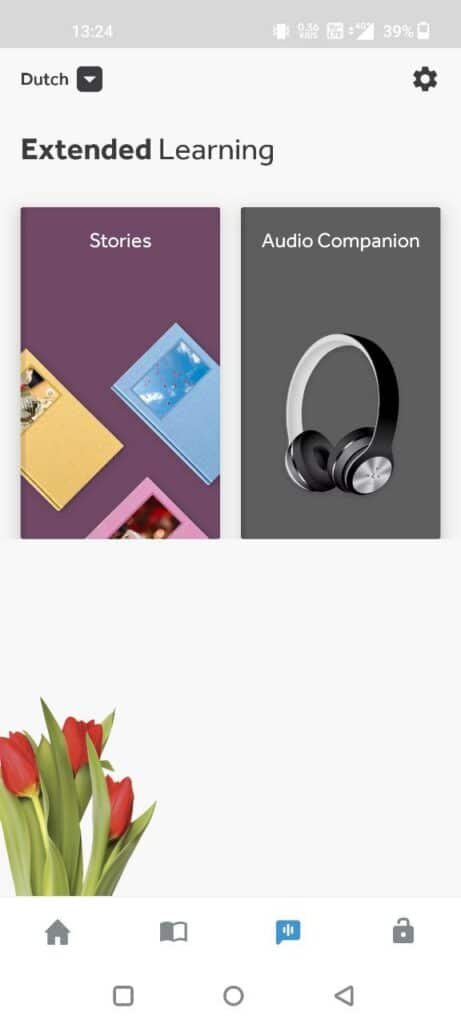
Rosetta Stone provides a variety of other tools and resources in addition to its main language-learning programs to help you on your way to learning a new language. These resources are:
- Grammar and vocabulary resources: To help you understand the language you are studying, Rosetta Stone offers a variety of grammar and vocabulary materials. These manuals include lists of widespread vocabulary terms, explanations of grammatical rules, and advice on how to improve your language abilities.
- Audio Materials: Rosetta Stone offers plenty of audio recordings featuring native speakers of the target language to help you improve your speaking and listening abilities. These recordings could include speeches, discussions, and other spoken material.
- Live tutoring sessions: Depending on the terms of your membership, you can have access to real-time conversations with someone who is fluent in the language you are learning. These sessions might help you learn the language faster since they are intended to provide you individualized assistance and feedback on your proficiency.
- Cultural notes: Rosetta Stone provides a variety of cultural notes and insights to assist you with understanding the target language in context. These notes could include advice for speaking successfully in various social and professional contexts as well as details on cultural traditions, customs, and etiquette.
Simply browse to the appropriate part of Rosetta Stone’s user interface to access these extra materials. You might have access to all of these materials or only a portion of them, depending on your membership package. Nevertheless, these tools are a useful tool for increasing your language learning experience and eventually reaching your language learning objectives regardless of your membership level.
Troubleshooting and Support
Even with Rosetta Stone’s user-friendly interface and cutting-edge technology, you can run into problems or have queries. Fortunately, Rosetta Stone provides a variety of support and solutions to assist you in resolving any difficulties and making the most of the application. Here are a few ways to access Rosetta Stone troubleshooting and support:
- Knowledge Base: Rosetta Stone has an extensive Knowledge Base that has articles on a variety of subjects, from how to fix technical problems to how to get the most of your language study. You can access the Knowledge Base from the Rosetta Stone website.
- Support: Rosetta Stone provides customer service through phone or chat if you are unable to solve a problem utilizing the Knowledge Base. The website offers customer service, and a person will be on hand to help you throughout normal business hours.
- User Community: Rosetta Stone provides a user community where language learners may exchange ideas and advise with one another in addition to official support materials. The user community is a fantastic resource for connecting with other language learners and finding answers to frequently asked topics.
Can You use Rosetta Stone on Your Phone?
Yes, you can use Rosetta Stone on your phone through the Rosetta Stone mobile app, which is available for both iOS and Android devices. The app has the same voice recognition, adaptive learning, and gamified learning as the PC version. The app lets you download courses and view them offline, making it simple to learn a new language.
How to use Rosetta Stone app while driving?
It is not advised to use the Rosetta Stone app in car since it can be hazardous and cause you to lose concentration. Any app for learning a language, like Rosetta Stone, needs your full attention and focus.
To prevent collisions or accidents, it’s critical to put your safety first when driving and to keep your attention entirely on the road. It’s preferable to use Rosetta Stone to learn a new language in a secure, distraction-free environment like home or a study room.
Always keep in mind that distracted driving is a severe safety risk and may result in collisions, injuries, and even deaths. Therefore, put your own safety and the safety of other road users first by putting off any distractions while driving.
How to use Rosetta Stone on Apple watch?
Rosetta Stone offers a companion app for the Apple Watch, which is designed to make learning languages more accessible and enjoyable. The app lets the user access simple sentence and word lessons, as well as other language-learning tools, right from their watch.
The Rosetta Stone Apple Watch app is available for free download on the App Store. The first language lesson is for free. In-app payments are necessary to unlock further classes.
The programme lets learners download audio lessons straight to their Apple Watch for offline usage. So, they can practise their language skills anywhere without their phone. However, downloading courses onto the watch might take several minutes. Learners will require a Bluetooth Audio Headset to listen to the sessions.
Conclusion
Rosetta Stone is an effective tool for language learning that provides a number of features that help users in learning a new language. How to learn with Rosetta stone? Start by selecting your preferred language, then personalize your learning environment and keep track on how you’re progressing.
The platform provides tools for customer service and may be accessed through a desktop or mobile app. There are even more mobile practise options with the new Apple Watch companion app. Overall, Rosetta Stone is a useful tool that helps you meet your language learning objectives.
FAQs
With its immersive learning strategy, Rosetta Stone aims to teach new words and ideas via context and visual assistance. The website offers planned courses that progressively build on one another to help language learners in improving their abilities.
Yes, you can use Rosetta stone for free. Customers can get the first few lessons in any language during a free trial of 3 days. This enables users to evaluate the platform and determine if it meets their language learning requirements.
Yes, Rosetta Stone subscribers can access their subscriptions on a variety of computers, laptops, tablets, and mobile phones.
A variety of customer assistance tools are available from Rosetta Stone. It has online help articles, live chat, email support, and phone support.
Yes, customers can discontinue using Rosetta Stone at any time. It’s crucial to keep in mind that certain subscription plans could impose a commitment time before allowing cancellation.
Yes, Rosetta Stone has been shown to be an effective tool for language learning. Rosetta Stone users enhance their language abilities more than non-users, according to research.

Meet Bill, a French language teacher and blogger who specializes in testing various language learning apps. He has been teaching French for nearly 4 decades and holds a Bachelor’s degree from Manhattanville College. With a passion for technology and how it can enhance language learning, Bill has spent years testing and reviewing different language learning platforms. His blog provides valuable insights into the pros and cons of each app, as well as tips for language learners of all levels.
